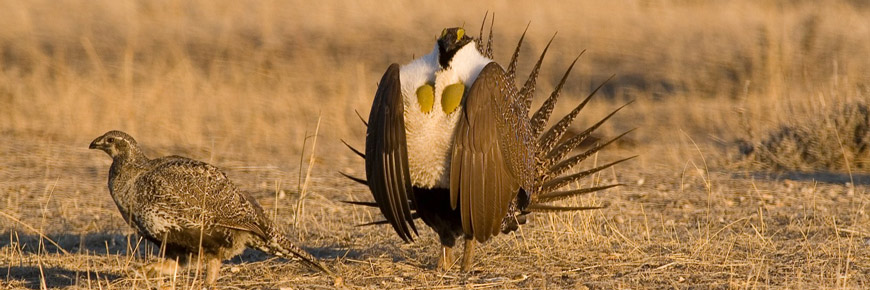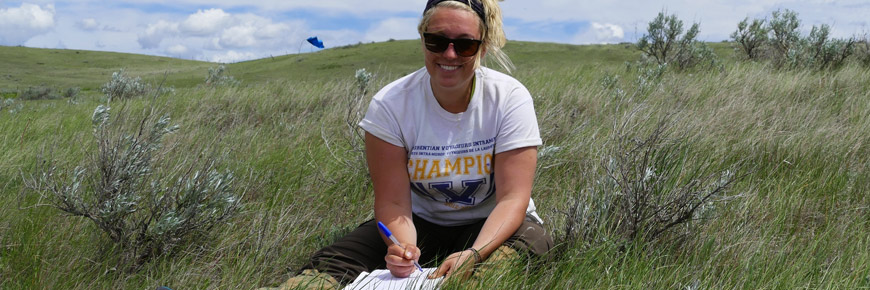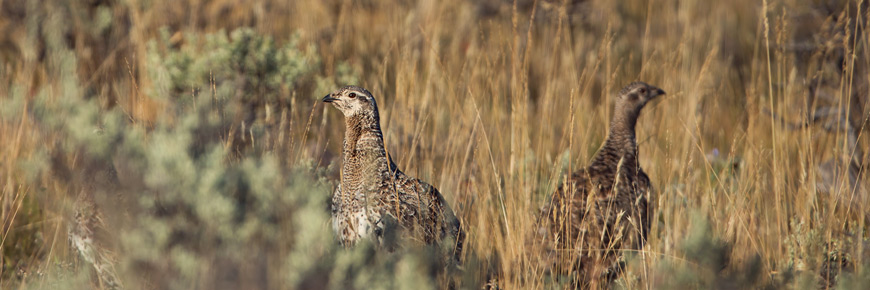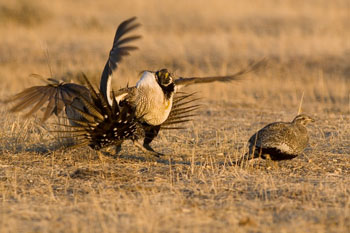
Greater Sage Grouse (Photo: Jon Groves)
Helping the Greater Sage-Grouse strut his stuff
A University of Alberta researcher is working with Parks Canada to help restore the sagebrush ecosystem in Grasslands National Park, Saskatchewan.
Walking this prairie landscape of big skies and waving grasslands, you might be startled by strange sounds—a short cooing followed by a “pop.” Someone uncorking champagne?
No, but you might just have been lucky enough to hear a Greater Sage-Grouse male trying to impress a female.
This iconic prairie species is found in shrinking ranges across North America. It is best known for its mating display: males will dance, puff themselves up, and pop the air sacs on their chest. This produces a sound that can travel up to 3 kilometres.
But that mating sound is becoming rarer on the prairies. Canada is now home to fewer than 400 Sage-Grouse. Their sagebrush habitat has been reduced by 94 percent through human activities such as agriculture and exploration for oil and gas.
Autumn Watkinson, a PhD student in the University of Alberta’s Department of Renewable Resources, is working to reverse that trend. Her thesis research focuses on restoring and enhancing sagebrush habitat in Grasslands National Park. The park is home to Saskatchewan’s last two Greater Sage-Grouse leks (mating areas).
Dr. M. Anne Naeth, a renowned land reclamation specialist from the University of Alberta, and Dr. Shelley Pruss, a species conservation specialist at Parks Canada, are contributing their knowledge by supervising Ms. Watkinson’s thesis work.
A new approach to restoring silver sagebrush

...[A] distance without limits, a horizon that did not bound the world but only suggested endless space beyond… It is a country to breed mystical people, egocentric people, perhaps poetic people, but not humble ones.
Sage brush is a silver-tinged, aromatic prairie shrub that can grow up to 2 metres in height. Greater Sage-Grouse cannot survive without it. The bird depends on the shrub for food, nesting sites, and cover from predators.
But sagebrush is very difficult to restore to the land. Common restoration methods, such as planting individuals grown in the greenhouse, result in only a 25 per cent success rate.
Ms. Watkinson is exploring a method that helps prepare greenhouse-grown sagebrush for survival after planting. The method involves giving the plants nutrients at different amounts and frequencies to promote root growth and storage of carbohydrates.
"We have been playing with the amount of nutrients administered and the timing of those nutrient deliveries,” says Ms. Watkinson. “So far we're seeing enhanced root growth in certain treatments, but we'll have to wait and see if that translates into increased survival and growth in the field."
The nutrient loading method has been successful in varying degrees with other woody plants, such as pine, spruce and oak, but this is the first time this method will be applied to a shrub species.
What’s at stake if we lose sagebrush

“This is not just about helping one beautiful bird,” says Ms. Watkinson. “Temperate grasslands are one of the most imperilled ecosystems on the planet. If the grouse disappears, so could other species associated with this landscape.”
Other species at risk in Grasslands National Park include the Burrowing Owl, Mountain Plover, Sage Thrasher, Swift Fox, Loggerhead Shrike and Peregrine Falcon.
Ms. Watkinson hopes her research will provide best management practices for sagebrush restoration right across North America. Her goal is the same as Parks Canada’s: to ensure that male Greater Sage-Grouse will strut their stuff for a long time to come.
Related links
- Date modified :
